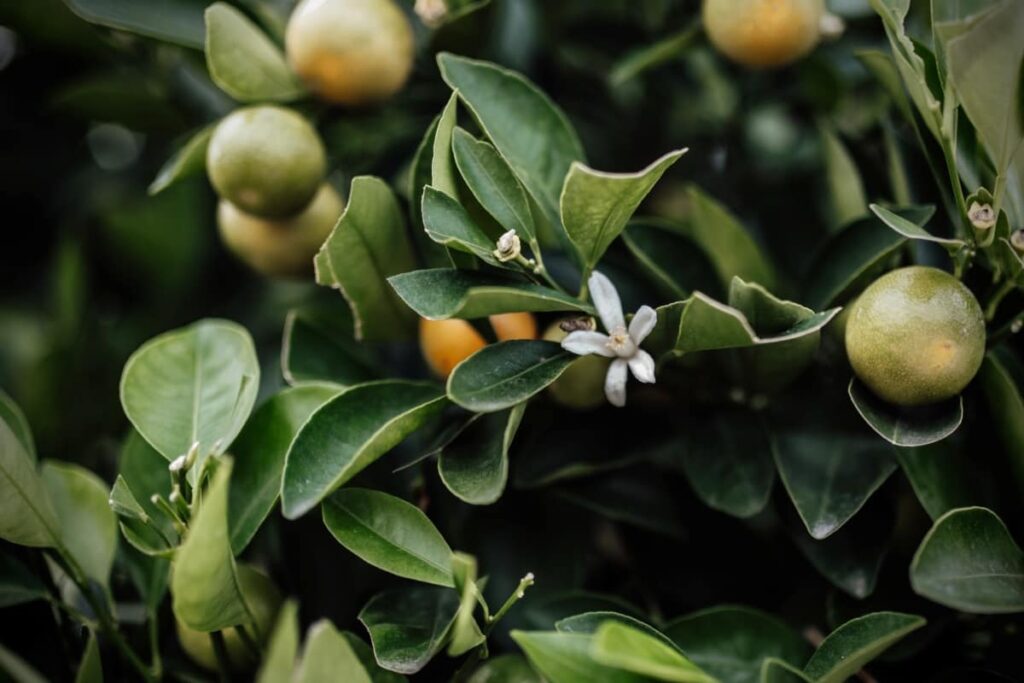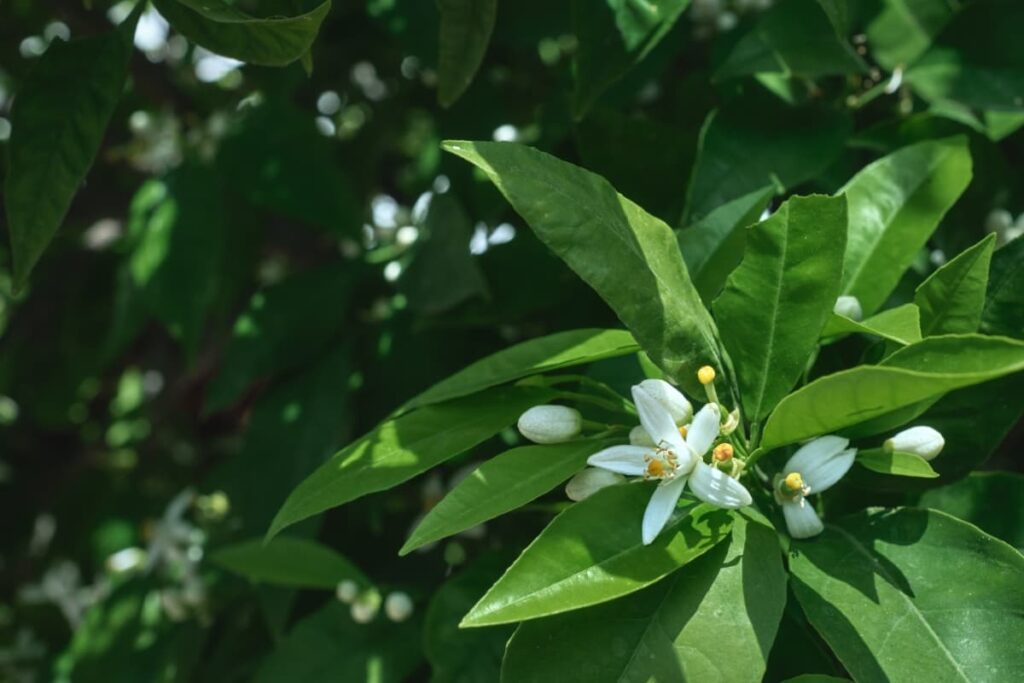Inducing Citrus flowers involves implementing various strategies to promote blooming in these delightful fruit-bearing plants. The genus Citrus, known for fruits like Oranges, Grapefruits, Limes, and Lemons, belongs to the rue family. Botanically called Citrus sps., these trees are cherished for their juicy harvests. Inducing Citrus flowers refers to the process of stimulating Citrus trees to produce flowers, which will eventually lead to fruit development.

Steps to Encourage and Induce Citrus Flowers
Variety Selection for Optimal Blooming
Each Citrus species has its blooming characteristics, so selecting the optimal one for your climate and soil conditions can make a big difference in flower production. For example, some varieties, like Valencia Oranges, are known for their abundant blooms, while others, like Meyer lemons, may require specific care to induce flowering.
Consider factors such as cold tolerance, heat resistance, and disease susceptibility when selecting your Citrus plants for optimal blooming potential. Research different Citrus varieties available in your region and choose ones that are well-suited to your specific growing conditions.
Sunlight Exposure Maximization
Ensure that your Citrus trees are positioned in a region where they can receive ample sunlight throughout the day. Citrus plants thrive in full sun, so aim to provide them with 6-8 hours of sunlight daily. By allowing more sunlight to reach the plant, you can promote optimal blooming and fruit production.
Irrigation Strategies for Flower Induction
Consistent watering is essential for healthy flower induction. Citrus trees prefer moist but well-drained soil, so finding the right balance is key. During the flowering season, pay close attention to your tree’s water needs. Adequate hydration will help promote bud formation and increase the chances of a bountiful harvest.
Consider using drip irrigation to deliver water directly to the roots while minimizing evaporation and ensuring efficient absorption. This method helps maintain consistent moisture levels without causing water stress or wastage. Adjusting your irrigation schedule based on weather conditions and seasonal changes is also important.
Nutrient-Rich Soil Preparation
Citrus trees thrive in well-draining soil with ample organic matter. Before planting, ensure the soil is rich in nutrients like N, P, and K to support healthy growth and blooming. Consider making a soil test to determine any deficiencies and adjust accordingly by adding compost or fertilizer. Organic options like composted manure can provide a slow release of nutrients over time, promoting steady flower production.
Maintaining proper pH levels is also essential for optimal nutrient absorption by the roots. Most Citrus trees prefer slightly acidic soil around the 6.0 to 7.0 pH range for ideal flowering conditions. Remember that healthy soil equals thriving plants; therefore, investing time and effort into nutrient-rich soil preparation will undoubtedly pay off in abundant Citrus blooms in your garden.
Balanced Fertilization Regimen
By providing the right nutrients in the right amounts, you can optimize bloom potential and fruit yield. When it comes to fertilizing Citrus trees, a balanced approach is key. N, P, and K (nitrogen, phosphorus, and potassium) are essential elements that should be carefully monitored and adjusted as needed.
Excessive fertilizer can affect an overabundance of foliage at the expense of flowers. On the other hand, insufficient nutrients can result in poor blooming and stunted growth. Make sure soil testing can help determine the nutrient levels in your soil and guide your fertilization regimen. This proactive approach ensures that your Citrus trees are receiving what they need to thrive.
Microelement Supplementation
Microelement supplementation plays a crucial role in encouraging Citrus flowers to bloom beautifully. These essential nutrients, such as iron, zinc, and manganese, are needed in small quantities but have a big impact on the overall health of the plant. Deficiencies in microelements can lead to stunted growth and poor flower production. By incorporating a balanced micronutrient regimen into your Citrus care routine, you can ensure that your plants have everything they need to thrive.
In case you missed it: 15 Best Fertilizers for Citrus Tree: Homemade, Organic, Liquid, NPK, Schedule, and Prices

When supplementing with microelements, it’s important to follow recommended guidelines and avoid overdoing it. Too much of a good thing can harm your plants rather than help them. Consider using foliar sprays or root drenches for effective absorption of these vital nutrients. Regular monitoring based on plant response is key to achieving optimal results.
Growth Regulator Applications
These applications help in controlling the timing of flowering, ensuring optimal blooming periods for your Citrus trees. Growth regulators work by influencing plant hormones, stimulating flower production, and enhancing overall fruit yield. By applying these regulators at the right time and in the correct dosage, you can effectively induce flowering in your Citrus trees.
It is essential to observe manufacturer instructions when using growth regulators to avoid any potential negative effects on your plants. Always consult with experts or professionals for guidance on which regulator products are best suited for your specific Citrus variety. With proper monitoring, growth regulator treatments can significantly boost flower formation and fruit development in your Citrus orchard.
Pruning for Flowering Enhancement
Pruning is a key technique to enhance flowering in Citrus trees. By strategically trimming branches and removing dead wood, you can promote new growth and increase the production of flowers. It’s important to prune your Citrus tree during the dormant season before new growth begins. Be sure to use sharp, clean tools to make precise cuts and avoid damaging the tree.
Additionally, thinning out crowded areas within the canopy can enhance air circulation and sunlight penetration, both crucial factors for promoting flower development. By selectively trimming back branches that are crisscrossing or growing inward, you create a more open structure that allows for better light exposure throughout the tree.
Stress Induction for Bloom Promotion
Stress induction can sometimes be a helpful technique to encourage Citrus trees to bloom. Exposing the trees to a short period of drought, for instance, can send signals that it’s time to produce flowers. However, this should be done cautiously and not taken to extremes, as prolonged stress can harm the tree.
Another method is root pruning or bending branches slightly, which can stimulate flowering. These mild stresses mimic natural conditions where the plant needs to reproduce before potentially unfavorable circumstances arise. Keep in mind that while some stress may promote blooming, excessive stress will weaken the tree and reduce fruit production in the long run. Always monitor your Citrus tree closely during any induced stress period and ensure it remains healthy overall.
Pest and Disease Management
Some common pests and diseases that may affect Citrus trees are Citrus Leaf Miner, Citrus Whitefly, Citrus Black Fly, Citrus Red Mite, Root Rot (Phytophthora), Citrus Canker, and Greasy Spot. Regular monitoring for pests like aphids, spider mites, and Citrus leaf miners can help prevent infestations that may hinder flowering. Proper spacing between trees and good airflow can also reduce diseases like Citrus canker or greening.
In case you missed it: How to Increase Citrus Fruit Size: Exploring Optimization for Larger Citrus Fruit Growth

By being proactive in identifying and addressing any issues related to these pests or diseases, you can help ensure the health of your Citrus trees, ultimately leading to increased flower production. Regularly inspecting your Citrus trees for any signs of disease is crucial in preventing widespread damage.
Conclusion
Citrus trees not only provide juicy fruits but also boast beautiful blossoms that can brighten up any space. To induce Citrus flowers successfully, it’s essential to select the right varieties that are more prone to bloom profusely. Maximizing sunlight exposure is crucial for optimal flower production. Ensuring your Citrus trees receive adequate irrigation and nutrient-rich soil preparation can help stimulate flowering.
- Irrigation and Water Management in Pineapple Farming
- Blossom to Harvest: Mastering Flowering and Pollination in Papaya Farming
- Pig Fattening Essentials: From Selection to Sale for Beginners
- Raising Wagyu Cattle: A Complete Guide for Premium Beef Production
- Soil Types and Their Water Holding Capacity
- Optimizing Irrigation Schedules for Coconut Groves for Enhanced Yield
- Espresso Your Garden: Coffee Grounds for Healthier Acid-Loving Plants
- The Best Soil Mix for Snake Plants: How to Mix Your Own Snake Plant Soil
- Green Thumb Success: Expert Tips for Cultivating Greenhouse Beans All Year Round
